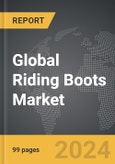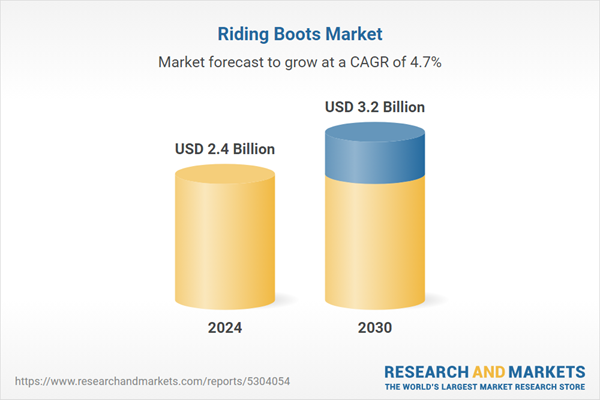The global market for Riding Boots was valued at US$2.4 Billion in 2024 and is projected to reach US$3.2 Billion by 2030, growing at a CAGR of 4.7% from 2024 to 2030. This comprehensive report provides an in-depth analysis of market trends, drivers, and forecasts, helping you make informed business decisions. The report includes the most recent global tariff developments and how they impact the Riding Boots market.
Segments: Product (Sport & Race Boots, Cruising & Touring Boots, Adventure & Dual Sport Boots); Distribution Channel (Offline, Online).
Geographic Regions/Countries: World; United States; Canada; Japan; China; Europe (France; Germany; Italy; United Kingdom; and Rest of Europe); Asia-Pacific; Rest of World.
The analysts continuously track trade developments worldwide, drawing insights from leading global economists and over 200 industry and policy institutions, including think tanks, trade organizations, and national economic advisory bodies. This intelligence is integrated into forecasting models to provide timely, data-driven analysis of emerging risks and opportunities.
Global Riding Boots Market - Key Trends and Drivers Summarized
How Are Riding Boots Essential for Equestrian Sports and Safety?
Riding boots are specialized footwear designed for equestrian activities, providing riders with protection, stability, and control. These boots are crafted to support various equestrian disciplines such as dressage, show jumping, and trail riding. With their distinct design featuring sturdy soles, tall shafts, and heels, riding boots help prevent the foot from sliding through the stirrup, enhancing safety. Traditionally made from leather, riding boots now incorporate materials like synthetic leather and waterproof fabrics, catering to a range of climates and preferences. This footwear is not only a functional necessity for riders but also an important element of equestrian fashion, merging tradition with style.What Are the Key Segments in the Riding Boots Market?
Key types include dress boots, field boots, and paddock boots. Dress boots, which extend up to the knee, are commonly used in formal equestrian disciplines, especially dressage, due to their sleek and elegant appearance. Field boots, equipped with laces at the ankle, are preferred in show jumping as they offer greater flexibility and comfort for the rider’s foot movements. Paddock boots, which are shorter and more versatile, are frequently used for general riding and training purposes, catering to beginners and casual riders. Materials for riding boots vary from traditional leather to modern synthetic and waterproof materials. Leather remains the most popular choice due to its durability, comfort, and timeless style. However, synthetic leather and waterproof fabrics are gaining traction, particularly in regions with diverse weather conditions, offering alternatives that are cost-effective and easy to maintain. End-users include professional riders, recreational riders, and children, with professional riders often investing in high-quality dress and field boots tailored for competition, while recreational riders and children may opt for paddock boots that provide flexibility and comfort for everyday riding.How Are Riding Boots Applied Across Different Equestrian Disciplines?
In dressage, riding boots, especially dress boots, are used for their structured design that aids in maintaining a formal posture and appearance. Show jumping relies heavily on field boots, which are flexible and supportive, enabling riders to navigate jumps comfortably. For trail riding and recreational purposes, paddock boots are favored due to their shorter shaft and comfort, allowing riders to wear them both on and off the horse. Many riding boots are also designed to complement specific saddles and tack, enhancing performance and aesthetic appeal in competitive and non-competitive settings alike.What Factors Are Driving the Growth in the Riding Boots Market?
The growth in the Riding Boots market is driven by several factors, including the rising popularity of equestrian sports, increasing fashion interest in equestrian wear, and advancements in boot materials. Innovations like waterproof materials, synthetic alternatives, and customized designs have expanded the appeal of riding boots across different demographics. The focus on enhancing safety, improving comfort, and blending style with function has further fueled demand, as riding boots provide essential support for riders across disciplines. Additionally, the growth of equestrian sports, increasing disposable incomes, and the rising trend of leisure riding have contributed to market growth, encouraging a broader adoption of riding boots worldwide.Report Scope
The report analyzes the Riding Boots market, presented in terms of units. The analysis covers the key segments and geographic regions outlined below.Segments: Product (Sport & Race Boots, Cruising & Touring Boots, Adventure & Dual Sport Boots); Distribution Channel (Offline, Online).
Geographic Regions/Countries: World; United States; Canada; Japan; China; Europe (France; Germany; Italy; United Kingdom; and Rest of Europe); Asia-Pacific; Rest of World.
Key Insights:
- Market Growth: Understand the significant growth trajectory of the Sport & Race Boots segment, which is expected to reach US$2.0 Billion by 2030 with a CAGR of a 4.6%. The Cruising & Touring Boots segment is also set to grow at 5.3% CAGR over the analysis period.
- Regional Analysis: Gain insights into the U.S. market, valued at $663.3 Million in 2024, and China, forecasted to grow at an impressive 4.3% CAGR to reach $499.7 Million by 2030. Discover growth trends in other key regions, including Japan, Canada, Germany, and the Asia-Pacific.
Why You Should Buy This Report:
- Detailed Market Analysis: Access a thorough analysis of the Global Riding Boots Market, covering all major geographic regions and market segments.
- Competitive Insights: Get an overview of the competitive landscape, including the market presence of major players across different geographies.
- Future Trends and Drivers: Understand the key trends and drivers shaping the future of the Global Riding Boots Market.
- Actionable Insights: Benefit from actionable insights that can help you identify new revenue opportunities and make strategic business decisions.
Key Questions Answered:
- How is the Global Riding Boots Market expected to evolve by 2030?
- What are the main drivers and restraints affecting the market?
- Which market segments will grow the most over the forecast period?
- How will market shares for different regions and segments change by 2030?
- Who are the leading players in the market, and what are their prospects?
Report Features:
- Comprehensive Market Data: Independent analysis of annual sales and market forecasts in US$ Million from 2024 to 2030.
- In-Depth Regional Analysis: Detailed insights into key markets, including the U.S., China, Japan, Canada, Europe, Asia-Pacific, Latin America, Middle East, and Africa.
- Company Profiles: Coverage of players such as Alpinestars S.p.A, Dainese S.p.A, Dan Post, Dingo, Durango and more.
- Complimentary Updates: Receive free report updates for one year to keep you informed of the latest market developments.
Some of the 53 companies featured in this Riding Boots market report include:
- Alpinestars S.p.A
- Dainese S.p.A
- Dan Post
- Dingo
- Durango
- FLY Racing
- FOX
- Frye
- GAERNE USA
- Irish Setter
- Justin Boots
- LeMans Corporation
- Lucchese
- Old Gringo
- Rocky
- Roper
- Stetson
- TCX S.r.l.
- Tony Lama
Tariff Impact Analysis: Key Insights for 2025
Global tariff negotiations across 180+ countries are reshaping supply chains, costs, and competitiveness. This report reflects the latest developments as of April 2025 and incorporates forward-looking insights into the market outlook.The analysts continuously track trade developments worldwide, drawing insights from leading global economists and over 200 industry and policy institutions, including think tanks, trade organizations, and national economic advisory bodies. This intelligence is integrated into forecasting models to provide timely, data-driven analysis of emerging risks and opportunities.
What’s Included in This Edition:
- Tariff-adjusted market forecasts by region and segment
- Analysis of cost and supply chain implications by sourcing and trade exposure
- Strategic insights into geographic shifts
Buyers receive a free July 2025 update with:
- Finalized tariff impacts and new trade agreement effects
- Updated projections reflecting global sourcing and cost shifts
- Expanded country-specific coverage across the industry
Table of Contents
I. METHODOLOGYII. EXECUTIVE SUMMARY2. FOCUS ON SELECT PLAYERSIII. MARKET ANALYSISIV. COMPETITION
1. MARKET OVERVIEW
3. MARKET TRENDS & DRIVERS
4. GLOBAL MARKET PERSPECTIVE
UNITED STATES
CANADA
JAPAN
CHINA
EUROPE
FRANCE
GERMANY
ITALY
UNITED KINGDOM
REST OF EUROPE
ASIA-PACIFIC
REST OF WORLD
Companies Mentioned (Partial List)
A selection of companies mentioned in this report includes, but is not limited to:
- Alpinestars S.p.A
- Dainese S.p.A
- Dan Post
- Dingo
- Durango
- FLY Racing
- FOX
- Frye
- GAERNE USA
- Irish Setter
- Justin Boots
- LeMans Corporation
- Lucchese
- Old Gringo
- Rocky
- Roper
- Stetson
- TCX S.r.l.
- Tony Lama
Table Information
| Report Attribute | Details |
|---|---|
| No. of Pages | 99 |
| Published | April 2025 |
| Forecast Period | 2024 - 2030 |
| Estimated Market Value ( USD | $ 2.4 Billion |
| Forecasted Market Value ( USD | $ 3.2 Billion |
| Compound Annual Growth Rate | 4.7% |
| Regions Covered | Global |









